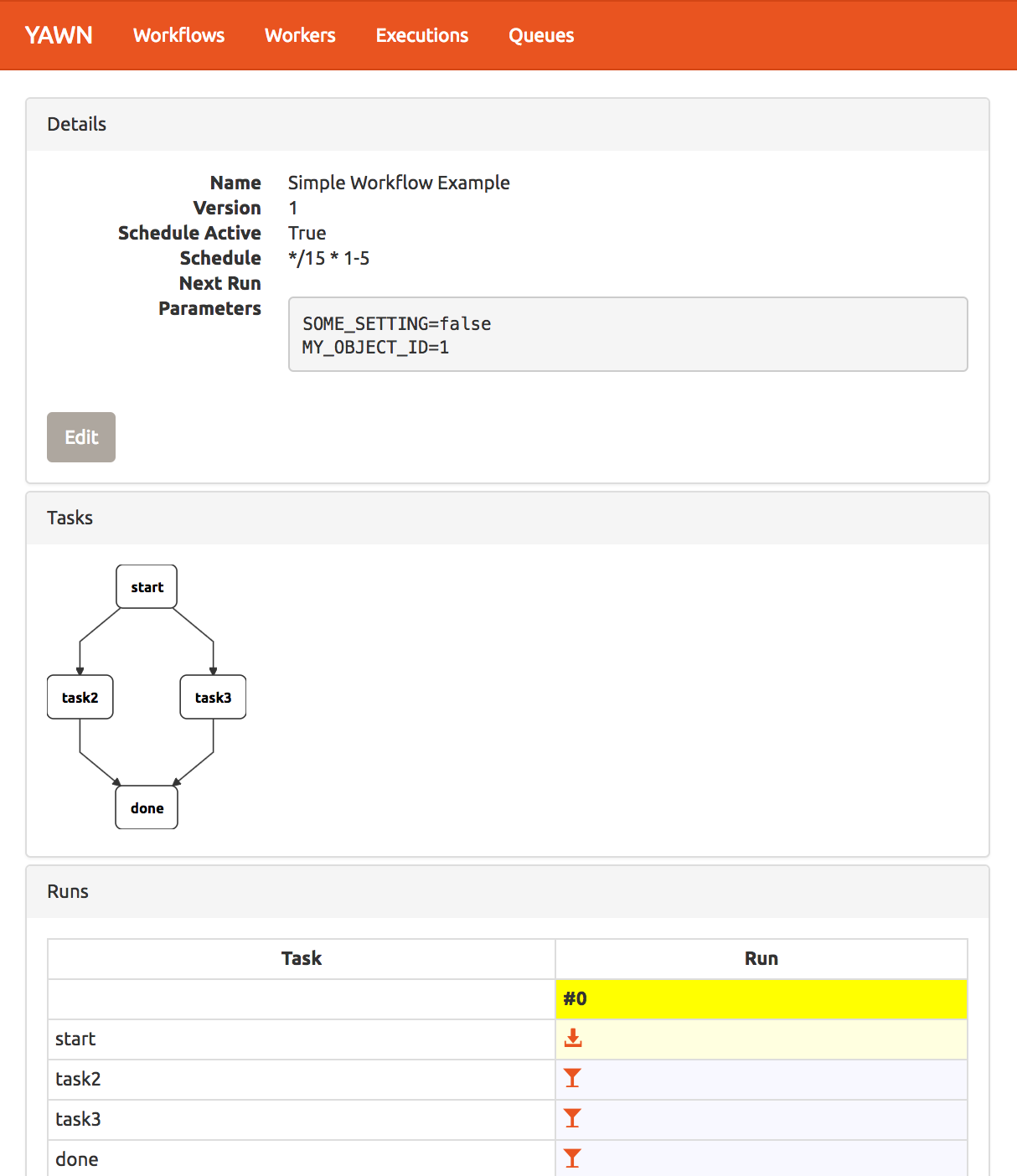Yet Another Workflow Engine, a subprocess-based DAG execution system
Project description
YAWN provides a framework for executing a set of shell commands with dependencies in a distributed manner and on a repeating schedule. Other tools do similar things and are inspirations for this one; particularly Celery and Airflow.
Principles
What is different from existing tools and why?
- Code separation
YAWN runs your commands as sub-processes, so there is no co-mingling of your python code with the YAWN code. You are responsible for how your code is released and what version of your code gets run.
- State separation
Environment variables are the only state that can be passed to your commands. Your application should key off just a date or record ID and get more complex state from its data sources.
- Versioning
The workflow configuration and every run is versioned, so you have a complete history.
- Broker
YAWN uses Postgres to store internal state and as a message queue. Using only Postgres allows for simple setup and configuration. YAWN uses the new SELECT ... FOR UPDATE SKIP LOCKED statement to efficiently select from the queue table.
Components
- Web Servers
The website provides a user interface to view the workflows and tasks running within them. It allows you to run an existing workflow or re-run a failed task. The web server also provides a REST API to programatically create and run workflows.
- Workers
The worker schedules and executes tasks. The worker uses subprocess.Popen to run tasks and capture stdout and stderr.
Concepts
- Workflow
A set of Tasks that can depend on each other, forming what is popularly known as a directed acyclic graph (DAG). Workflows can be scheduled to run on a regular basis and they are versioned so they can change over time.
- Run
A manually triggered or scheduled run of a Workflow.
- Task
A shell command that specifies the upstream tasks it depends on, the number times to retry, and a timeout. The task is given environment variables configured in the workflow and run.
- Execution
A single execution of a Task’s command, capturing the exit code and standard output and error.
- Queue
A first-in, first-out list of Tasks to execute.
- Worker
A process that reads from a set of Queues and executes the associated Tasks, recording the results in an Execution.
Examples
Run yawn examples to populate two workflows into the database.
Here is a screenshot of the page for a single workflow:

REST API
Browse the API by going to http://127.0.0.1:8000/api/ in a browser.
When creating a workflow, the format is (shown as YAML for readability):
name: Example parameters: ENVIRONMENT: production CALCULATION_DATE: 2017-01-01 schedule: 0 0 * schedule_active: True tasks: - name: task_1 queue: default max_retries: 1 timeout: 30 command: python my_awesome_program.py $ENVIRONMENT - name: task_2 queue: default command: echo $CALCULATION_DATE | grep 2017 upstream: - task_1
- /api/workflows/
GET a list of versions or a single workflow version. POST to create or update a workflow using the schema show above. PATCH to change the schedule, schedule_active, or parameters fields only.
POST - use the schema shown above
PATCH {"schedule_active": false}
- /api/runs/
GET a list of runs, optionally filtering to a particular workflow using ?workflow=<id>. POST to create a new run. PATCH to change the parameters.
POST {"workflow_id": 1, "parameters": null}
PATCH {"parameters": {"ENVIRONMENT": "test"}}
- /api/tasks/<id>/
GET a single task from a workflow run, and its executions with their status and logging information. PATCH to enqueue a task or kill a running execution.
PATCH {"enqueue": true}
PATCH {"terminate": <execution_id>}
Python API
Import and use the Django models to create your workflow:
from yawn.workflow.models import WorkflowName
from yawn.task.models import Template
name, _ = WorkflowName.objects.get_or_create(name='Simple Workflow Example')
workflow = name.new_version(parameters={'MY_OBJECT_ID': '1', 'SOME_SETTING': 'false'})
task1 = Template.objects.create(workflow=workflow, name='start', command='echo Starting...')
task2 = Template.objects.create(workflow=workflow, name='task2', command='echo Working on $MY_OBJECT_ID')
task2.upstream.add(task1)
task3 = Template.objects.create(workflow=workflow, name='task3',
command='echo Another busy thing && sleep 20')
task3.upstream.add(task1)
task4 = Template.objects.create(workflow=workflow, name='done', command='echo Finished!')
task4.upstream.add(task2, task3)
workflow.submit_run(parameters={'child': 'true'})
Alternatively, use the serializer to give tasks as a dictionary in the format used by the API. This method checks if a version of the Workflow exists with the same structure, and will return the existing version if so:
from yawn.workflow.serializers import WorkflowSerializer serializer = WorkflowSerializer(data=test_views.data()) serializer.is_valid(raise_exception=True) workflow = serializer.save() workflow.submit_run()
Contributing
To develop on YAWN, fork the repository and checkout a local copy:
git clone https://github.com/<you>/yawn
Install the backend Django dependencies and run its server. Your database should be at postgres://localhost:5432/yawn by default. The yawn command is a wrapper on Django’s manage.py:
pip install -e .[test] createdb yawn yawn migrate yawn runserver
Install the frontend create-react-app dependencies and run its server:
cd frontend npm install npm start
Run the tests:
pytest npm test
Load some examples and run the worker to process them:
yawn examples yawn worker
Project details
Release history Release notifications | RSS feed
Download files
Download the file for your platform. If you're not sure which to choose, learn more about installing packages.











